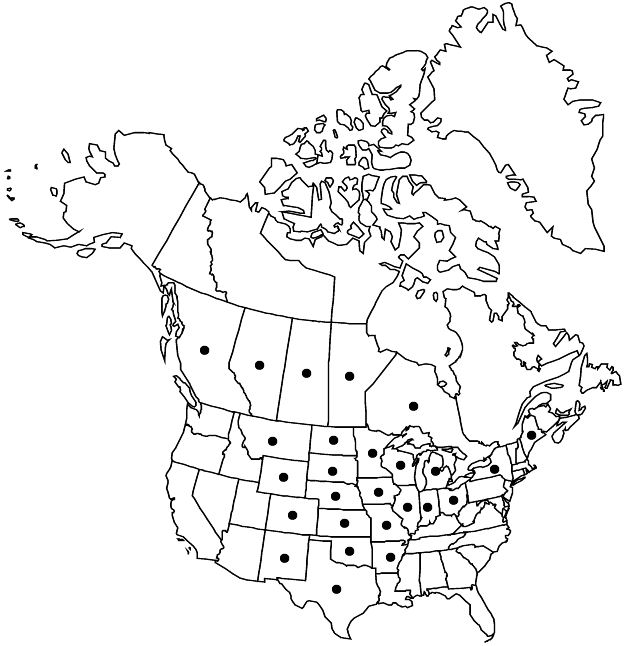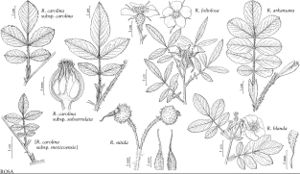Rosa arkansana
in T. C. Porter and J. M. Coulter, Syn. Fl. Colorado, 38. 1874.
Shrubs, forming hedge clusters. Stems erect, slender or stout, 6–15 dm, openly branched; bark dull red to purplish red, glabrous; infrastipular prickles rarely present, internodal prickles densely mixed with aciculi to stem apices, erect, terete, 1–3 (–4) × 0.5–2 mm, base rarely extending to 3 mm, smallest often gland-tipped, aciculi rarely absent. Leaves 5–10 (–16) cm; stipules 18–24 × 4–7 mm, auricles flared, 2.5–4 (–7) mm, margins undulate, coarsely or shallowly glandular-serrate, surfaces glabrous or puberulent, eglandular; petiole and rachis sometimes with pricklets, sometimes with sparse aciculi, pubescent, sometimes glabrous, rarely stipitate-glandular; leaflets (5–) 7–9 (–11), terminal: petiolule 4–12 mm, blade obovate, sometimes elliptic, 15–40 × 8–20 mm, membranous, margins 1 (–2+) -serrate, teeth 8–16 per side, eglandular, rarely gland-tipped, apex acute, abaxial surfaces pale green, pubescent, sometimes glabrous, eglandular, adaxial green, ± glaucous, dull, sometimes pubescent (especially along midveins). Inflorescences corymbs, 1–6 (–16) -flowered. Pedicels erect, slender, 10–20 mm, glabrous, eglandular; bracts 1 or 2 (or 3), broadly lanceolate, 11–20 × 5–8 mm, margins entire, eglandular, surfaces glabrous, eglandular. Flowers 3.3–4 cm diam.; hypanthium globose, 5–6.5 × 4–5.5 mm, glabrous, eglandular, neck (0–) 0.5–1.5 × 2 mm; sepals spreading to erect, lanceolate, 11–20 (–30) × (1.5–) 3–4 mm, tip 3–7 × 0.5–1 mm, margins pinnatifid or entire, abaxial surfaces glabrous, stipitate-glandular or eglandular; petals single, rarely double, pink or rose, sometimes fading white, rarely white, 22–26 × 21–30 mm; stamens 120; carpels 26–43, styles exsert 1.5–2 mm beyond stylar orifice (1.5 mm diam.) of hypanthial disc (3 mm diam.). Hips dull orange-red, globose, subglobose, or oblong, 10–11 × 7.5–13 mm, fleshy, glabrous, eglandular, rarely stipitate-glandular, neck 0–2 mm; sepals persistent, erect at hip maturity. Achenes basiparietal, 12–15, dark buff, ellipsoid, 4.5–5 × 2.5 mm. 2n = 28.
Phenology: Flowering May–Jul.
Habitat: Rocky slopes, dry hillsides, prairies, bluffs, open woods, grassy roadsides
Elevation: 200–2100 m
Distribution

Alta., B.C., Man., Ont., Sask., Ark., Colo., Ill., Ind., Iowa, Kans., Maine, Mich., Minn., Mo., Mont., Nebr., N.Mex., N.Y., N.Dak., Ohio, Okla., S.Dak., Tex., Wis., Wyo.
Discussion
Rosa arkansana is one of the more invasive indigenous roses in North America. Collections from Maine, Massachusetts, New York, North Carolina, Ontario, Quebec, and Vermont, where nativity is unknown, are introductions that by and large are ephemeral. In other states where R. arkansana is native, disjunct populations may be either introduced or ephemeral, including those in Illinois, Indiana, Michigan, Ohio, and north-central Texas in disturbed areas. It is indigenous from northeastern British Columbia to Manitoba, east to Ohio, western Missouri, northeastern New Mexico, and Colorado in prairies and plains, and within the eastern Rocky Mountains of the North American Prairies Province (A. Cronquist 1982).
Rosa arkansana possibly arose from the diploid R. blanda and R. woodsii complex as an autopolyploid (S. Joly et al. 2006). It hybridizes with R. carolina; the hybrids are known as R. ×medioccidentis W. H. Lewis.
The Chippewa use root infusions or decoctions of Rosa arkansana as anticonvulsants, to treat bleeding wounds, and as stimulants and tonics; Omahas (Nebraska) use roots as an eye medicine and petals as a perfume for hair oil (D. E. Moerman 1998).
In a breeding program initiated by Agriculture-Canada to establish winter hardy roses for the Canadian prairies, the best results were obtained by crossing Rosa arkansana and, sometimes, R. spinosissima with floribundas and hybrid teas to produce new cultivars such as ‘Prairie Joy’ (L. M. Collicutt 1992) and ‘Winnipeg Parks’ (Collicutt 1992b).
Selected References
None.
Lower Taxa
"thin" is not a number."dm" is not declared as a valid unit of measurement for this property."dm" is not declared as a valid unit of measurement for this property.
